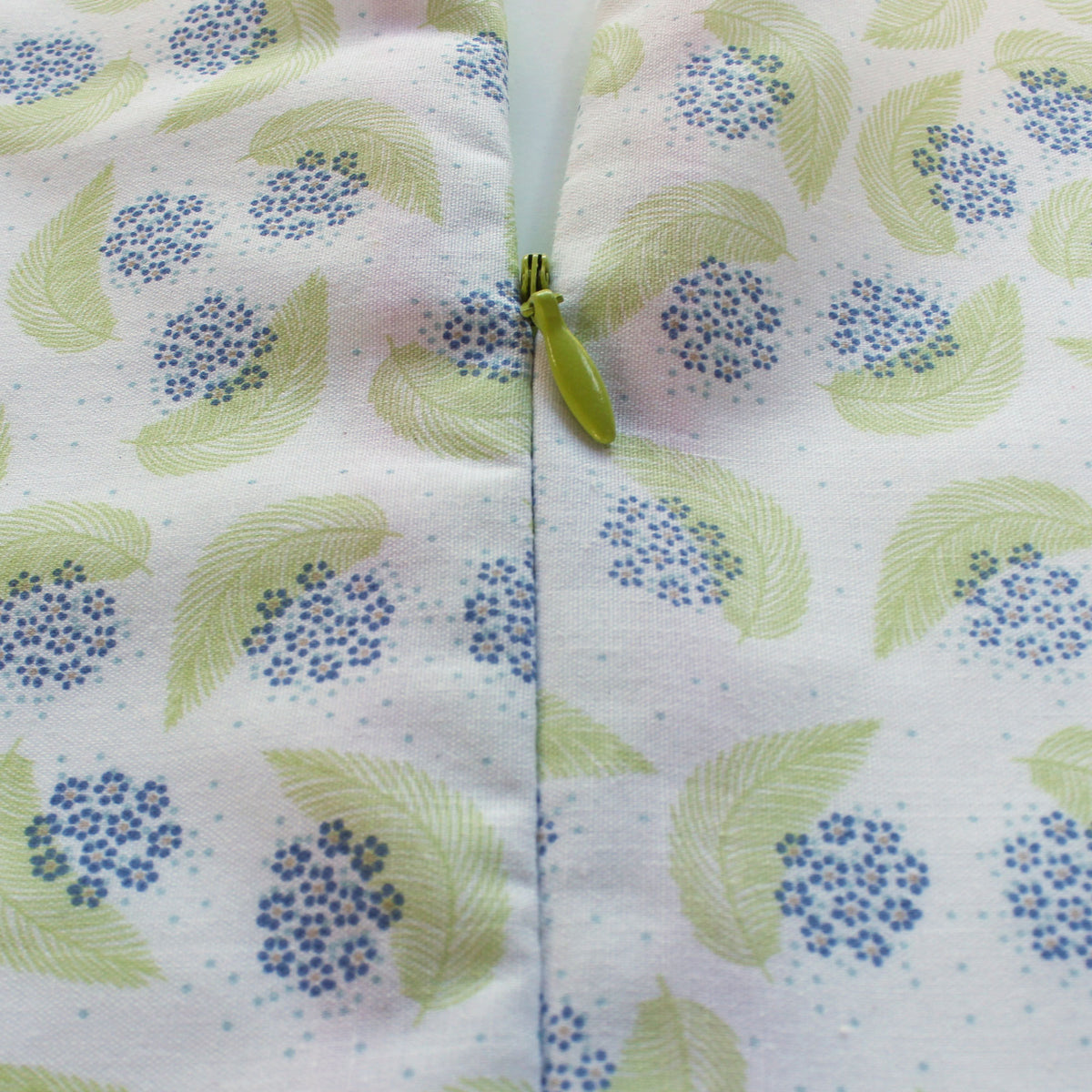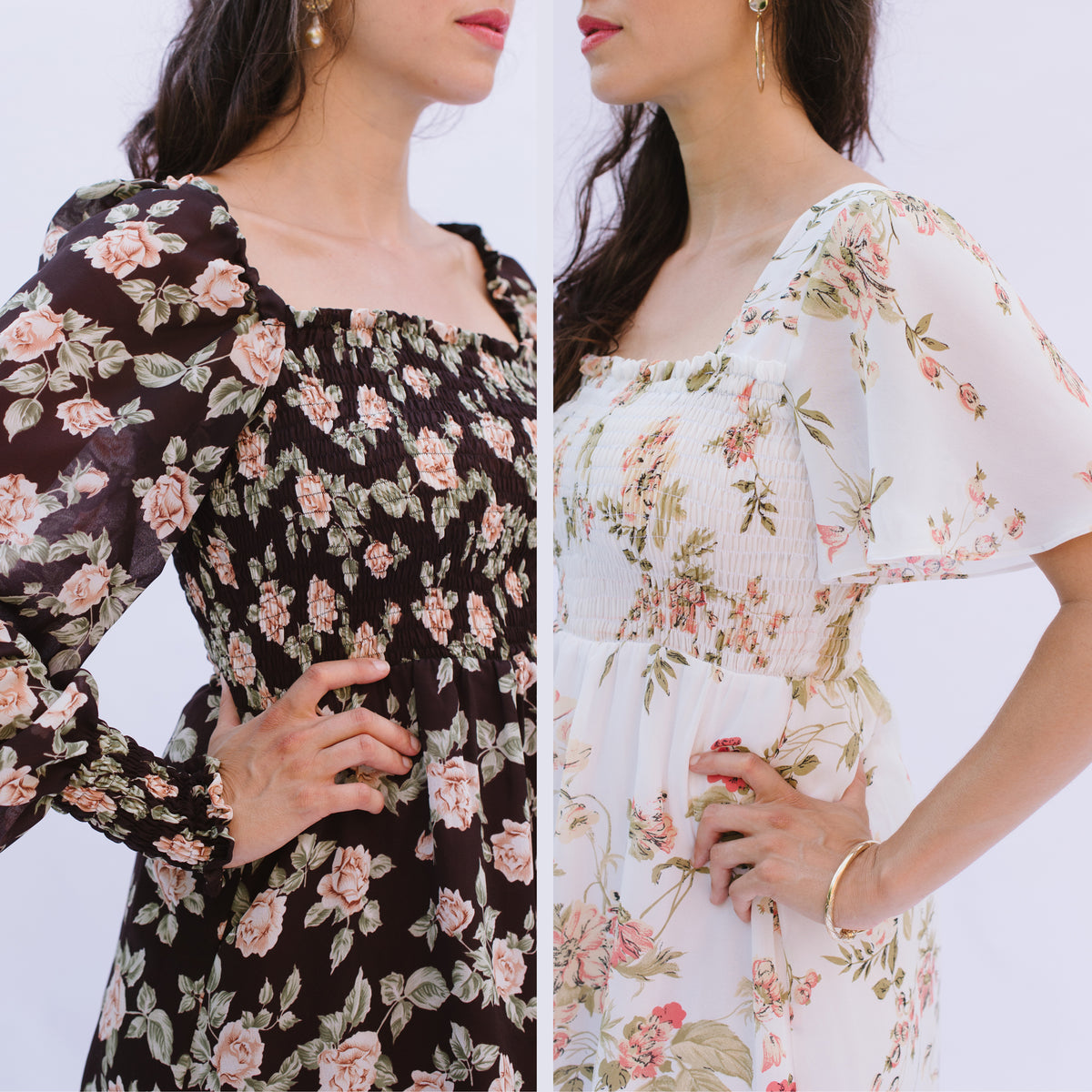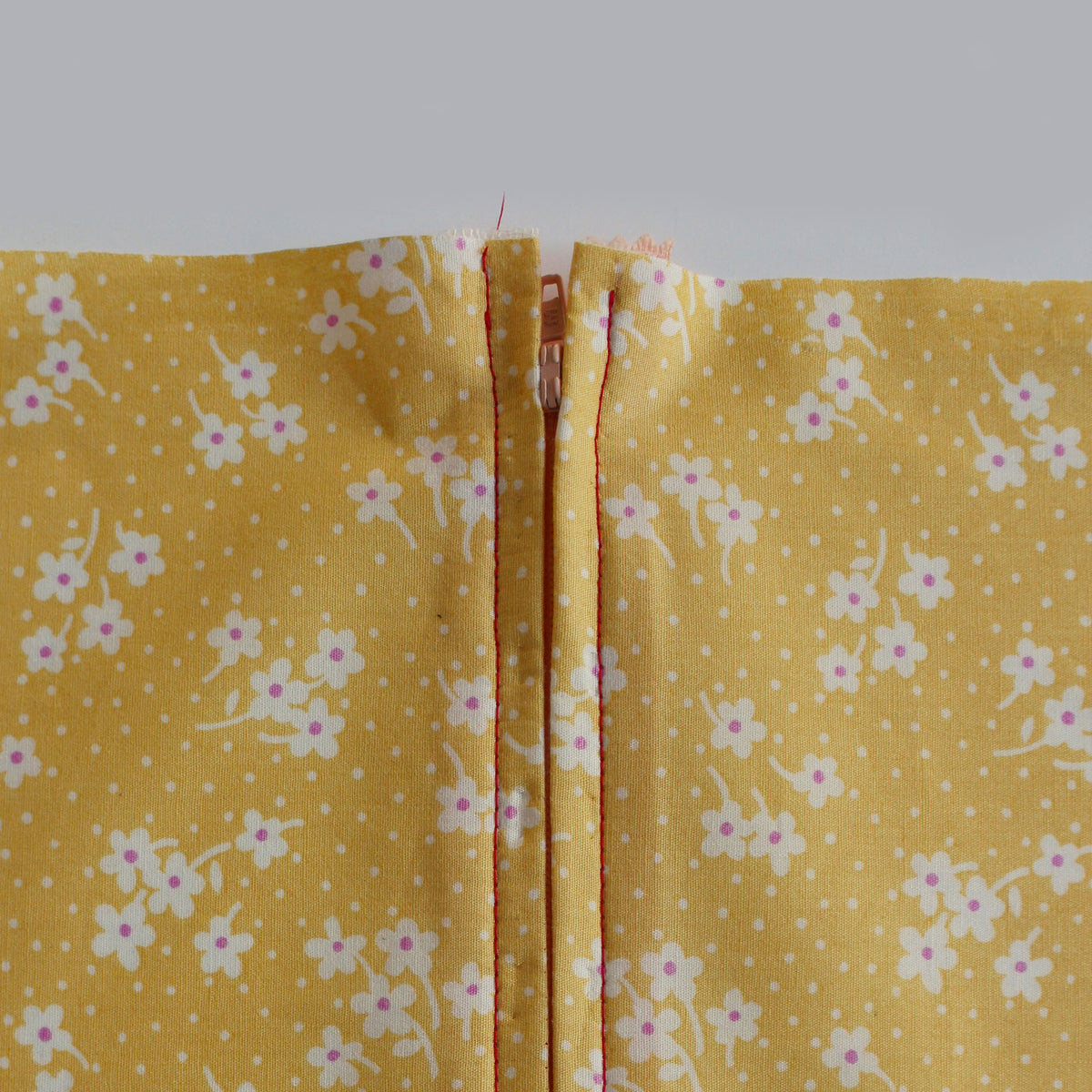
Today we will be sewing the dress front and back together. You'll need to pay close attention when sewing the dress back, as multiple layers of fabric meet at one point. The requires precision sewing in order to achieve a neat finish. We'll show you how it's done!
For those of you using a serger, note that the back dress will require you to use a regular sewing machine for certain portions of the project. Also, just a reminder that the seam allowance is 1/4" (6mm).
DRESS FRONT:
Place the Front Center (A) piece right side up onto your table. To one side of the piece, align and pin one of the Front Side (B) pieces, making sure that right sides of either piece are facing.
There are several notches along the edge; make sure to align them as you pin.

At the neckline, make sure the neckline edge from both aligns as precisely as possible. This will make sewing the neckline facing easier in later steps.
Begin sewing at the neckline and work towards the hem. This is done so that the area that requires most accuracy, in the case the neckline, can be sewn with precise alignment at the beginning of the stitch.

Repeat the steps for the opposite side so that the Dress Front is complete.


On either side, press the seam allowance toward the side edges.

DRESS BACK:
The upper back portion of the dress requires some precision sewing. As you work through these instructions, just take your time and work carefully with your needle placement and backstitching.
We'll be using a sewing machine for the first few steps. Select your straight stitch, or use a narrow zig zag. I'll remind you of the recommended settings for these stitches, but if you haven't already, test the stitch on your fabric before sewing.
Stretch stitch:
Setting: Stretch stitch
Stitch Length: 2.5 mm
Stitch Width: 1 mm
Narrow zig-zag:
Stitch setting: Regular zig-zag
Stitch Length: 2.2 mm
Width: 1.5 mm
Place the Back Upper Center (E) pieces right sides together. You will also place the two Back Facing (D) pieces right sides facing.

For each set, align and pin the pieces together along the center back edge. Insert a pin precisely at the match point on one piece and exit through the match point on the other piece.
The Back Upper Center (E) pieces are pictured here, but repeat this for the Back Facing (D) pieces as well.

Pin along the remaining center back edge, in between the match point and the waist edge. Do the same for the Back Facing set (D).

For each set of pieces, we are going to sew along the center back edge, starting at the marker point and working towards the waist. We want the enter the sewing needle precisely at the marker point, so here's what you do.
- Place the first set (E or D) under the pressure. Using your hand wheel, carefully insert the sewing needle into the fabric precisely at the match point, then drop the foot.
- Sew a neat and secure backstitch at the match point, being careful not to backstitch past the match point mark.
- Continue to sew towards the waistline edge.
The backstitching in these next few steps should be "solid" but not excessive; when you insert your needle into the fabric at the indicated marker point, sew forward and backward with three or four stitches. Sewing more than this could lead to torn fabric if stitch ripping is required.


Clip a "V" into the seam allowance at the match points. Be careful to cut to, but not through, the stitch line.

Press the seam allowance open.


Place the Back Facing (F) unit right sides together with the Back Center Unit (E).

Connect the two units at the match points with a pin. Make sure that the units are precisely aligned at this point.

Pin the units together along one side of the center back edge.

We'll start by sewing this side first. Insert your needle to match precisely to the backstitch that you have sewn in the previous step.

Drop your needle in place, making sure it is in the correct position before you begin sewing.


Sew along the center back edge, from the match point/backstitch towards the neckline edge.

Now, turn the sewn side of the unit aside. Pin the remaining center back edges of the unit together.

Once again, insert your needle to match precisely to the backstitch that you have sewn in the previous step. Sew along the edge towards the neckline.

Let's check our stitch line to make sure we nailed it! If the stitch aligns perfectly with the backstitch, you're golden!

If your stitch line is slightly off from your backstitch, the next two steps will show you how to fix it in order for the finished edge lay flat at this seam intersection.

With chalk, I've drawn a line from my existing stitch line to by backstitch. I'll make sure to sew carefully along this line, ending precisely at the backstitch.

Once I'm happy with my stitch, I'll remove the unnecessary portion of the previous stitch line.

When the garment is turned right side out, the intersection of these stitches should be nice and tidy.

But before turning the unit right side out, let's just trim away some excess seam allowance in order to reduce some of the bulk along the center back edge. Even though it's a small amount, it makes a difference to our final seam. Be careful when cutting so that you don't snip into your seam.
Trim away half of the seam allowance - approximately 1/8", (3 mm) from the Back Facing (D) piece.

On both sides of the unit, press the center back seam allowance towards the Back Facing (D).

We'll now understitch along each of the center back edges. Sewing an understitch helps to prevent the inner portion of the garment, in this case, the Back Facing (D), from rolling out towards the right side of the garment.
For knit fabric, I like to sew this stitch with a regular zig-zag stitch. The settings for this stitch are as follows:
Setting: Zig-zag
Stitch Length: 2.5 mm
Stitch Width: 3 mm
Sew the understitch with the right side of the garment facing you. You will sew onto the facing side of the seam, making sure that the seam allowance is captured in this stitch.
My trick for understitching is to handle the fabric in a way where I can feel the seam allowance underneath. This way I can be sure that the seam allowance is turned in the right direction. Sometimes, even though we've pressed the seam, it can turn to the other side as you sew, so this little trick will help.
Also, as I sew the understitch, I gently pull the fabric to either side of the needle. This makes sure that the seam lays perfectly open. This is especially helpful for curved seams that may be hard to press.

The finished understitch!

Turn the Back Facing (D) unit towards the wrong side of the Back Upper Center (E) unit. Press along the finished center back edges.

Lay the Fack Facing/Back Upper Centre out flat on the table. Align the waistline edge. Pin and baste the waistline edge at a scant 1/4" (6 mm) seam allowance.

With right sides together, pin the assembled Back Upper Center/Back Facing unit to the Back Lower Center (F) along the waistline edge.
Sew the waistline seam. You can return to your serger now if you were using it in previous steps.

Press the waistline seam allowance down towards the hem of the skirt.

With right side together, align one of the Back Side (G) pieces together with the assembled Back Center unit. You'll find a match point at the waist of the Back Side piece; align this to the waist seam of the center unit.

Make sure to align notches along the side edges as you pin.

Sew the seam, beginning at the neckline and sewing towards the hem.
Repeat the steps to attach the otherBack Side (G) piece.

Press the seam allowance from both seams towards the side edges of the assembled piece.

Congratulations! The back of your dress is complete!!!
Fit test!
You may have already worked out the fit with a muslin, but if you haven't, now is a good time to test the fit of your dress. Simply baste the dress front and back together using your sewing machine. This will allow you to determine if any changes are needed before we continue. Once you've finished with the fitting, remove the baste stitches. And a little tip, if you need to remove anything from the side seams at the armhole, this same amount will need to be removed from the side edges of the sleeve.
YOU MAY ALSO LIKE:





